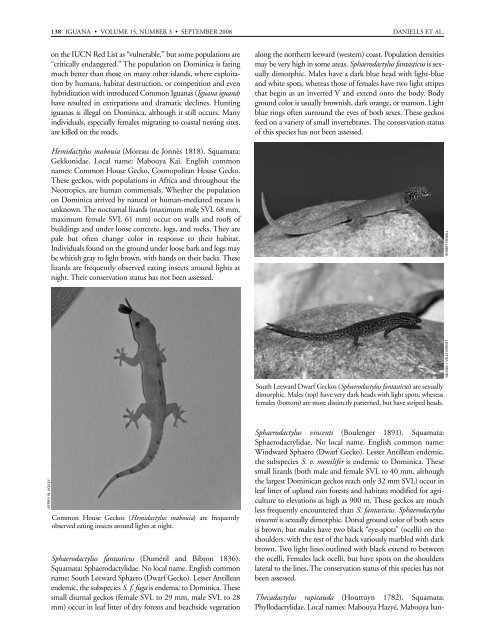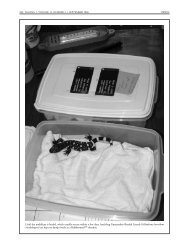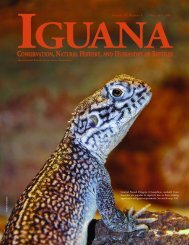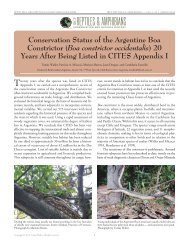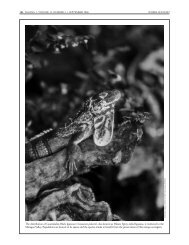Spiny-tailed Iguanas (Ctenosaura similis) in Venezuela
Spiny-tailed Iguanas (Ctenosaura similis) in Venezuela
Spiny-tailed Iguanas (Ctenosaura similis) in Venezuela
Create successful ePaper yourself
Turn your PDF publications into a flip-book with our unique Google optimized e-Paper software.
JEFFREY W. ACKLEY<br />
138 IGUANA • VOLUME 15, NUMBER 3 • SEPTEMBER 2008 DANIELLS ET AL.<br />
on the IUCN Red List as “vulnerable,” but some populations are<br />
“critically endangered.” The population on Dom<strong>in</strong>ica is far<strong>in</strong>g<br />
much better than those on many other islands, where exploitation<br />
by humans, habitat destruction, or competition and even<br />
hybridization with <strong>in</strong>troduced Common <strong>Iguanas</strong> (Iguana iguana)<br />
have resulted <strong>in</strong> extirpations and dramatic decl<strong>in</strong>es. Hunt<strong>in</strong>g<br />
iguanas is illegal on Dom<strong>in</strong>ica, although it still occurs. Many<br />
<strong>in</strong>dividuals, especially females migrat<strong>in</strong>g to coastal nest<strong>in</strong>g sites,<br />
are killed on the roads.<br />
Hemidactylus mabouia (Moreau de Jonnès 1818). Squamata:<br />
Gekkonidae. Local name: Mabouya Kai. English common<br />
names: Common House Gecko, Cosmopolitan House Gecko.<br />
These geckos, with populations <strong>in</strong> Africa and throughout the<br />
Neotropics, are human commensals. Whether the population<br />
on Dom<strong>in</strong>ica arrived by natural or human-mediated means is<br />
unknown. The nocturnal lizards (maximum male SVL 68 mm,<br />
maximum female SVL 61 mm) occur on walls and roofs of<br />
build<strong>in</strong>gs and under loose concrete, logs, and rocks. They are<br />
pale but often change color <strong>in</strong> response to their habitat.<br />
Individuals found on the ground under loose bark and logs may<br />
be whitish gray to light brown, with bands on their backs. These<br />
lizards are frequently observed eat<strong>in</strong>g <strong>in</strong>sects around lights at<br />
night. Their conservation status has not been assessed.<br />
Common House Geckos (Hemidactylus mabouia) are frequently<br />
observed eat<strong>in</strong>g <strong>in</strong>sects around lights at night.<br />
Sphaerodactylus fantasticus (Duméril and Bibron 1836).<br />
Squamata: Sphaerodactylidae. No local name. English common<br />
name: South Leeward Sphaero (Dwarf Gecko). Lesser Antillean<br />
endemic, the subspecies S. f. fuga is endemic to Dom<strong>in</strong>ica. These<br />
small diurnal geckos (female SVL to 29 mm, male SVL to 28<br />
mm) occur <strong>in</strong> leaf litter of dry forests and beachside vegetation<br />
along the northern leeward (western) coast. Population densities<br />
may be very high <strong>in</strong> some areas. Sphaerodactylus fantasticus is sexually<br />
dimorphic. Males have a dark blue head with light-blue<br />
and white spots, whereas those of females have two light stripes<br />
that beg<strong>in</strong> as an <strong>in</strong>verted V and extend onto the body. Body<br />
ground color is usually brownish, dark orange, or maroon. Light<br />
blue r<strong>in</strong>gs often surround the eyes of both sexes. These geckos<br />
feed on a variety of small <strong>in</strong>vertebrates. The conservation status<br />
of this species has not been assessed.<br />
South Leeward Dwarf Geckos (Sphaerodactylus fantasticus) are sexually<br />
dimorphic. Males (top) have very dark heads with light spots, whereas<br />
females (bottom) are more dist<strong>in</strong>ctly patterned, but have striped heads.<br />
Sphaerodactylus v<strong>in</strong>centi (Boulenger 1891). Squamata:<br />
Sphaerodactylidae. No local name. English common name:<br />
W<strong>in</strong>dward Sphaero (Dwarf Gecko). Lesser Antillean endemic,<br />
the subspecies S. v. monilifer is endemic to Dom<strong>in</strong>ica. These<br />
small lizards (both male and female SVL to 40 mm, although<br />
the largest Dom<strong>in</strong>ican geckos reach only 32 mm SVL) occur <strong>in</strong><br />
leaf litter of upland ra<strong>in</strong> forests and habitats modified for agriculture<br />
to elevations as high as 900 m. These geckos are much<br />
less frequently encountered than S. fantasticus. Sphaerodactylus<br />
v<strong>in</strong>centi is sexually dimorphic. Dorsal ground color of both sexes<br />
is brown, but males have two black “eye-spots” (ocelli) on the<br />
shoulders, with the rest of the back variously marbled with dark<br />
brown. Two light l<strong>in</strong>es outl<strong>in</strong>ed with black extend to between<br />
the ocelli. Females lack ocelli, but have spots on the shoulders<br />
lateral to the l<strong>in</strong>es. The conservation status of this species has not<br />
been assessed.<br />
Thecadactylus rapicauda (Houttuyn 1782). Squamata:<br />
Phyllodactylidae. Local names: Mabouya Hazyé, Mabouya ban-<br />
NELSON J. VÉLEZ ESPINET ROBERT POWELL


